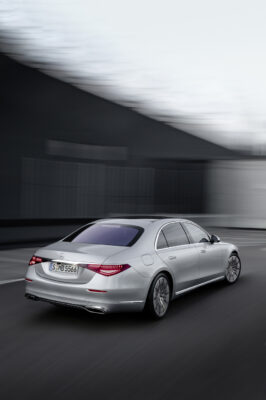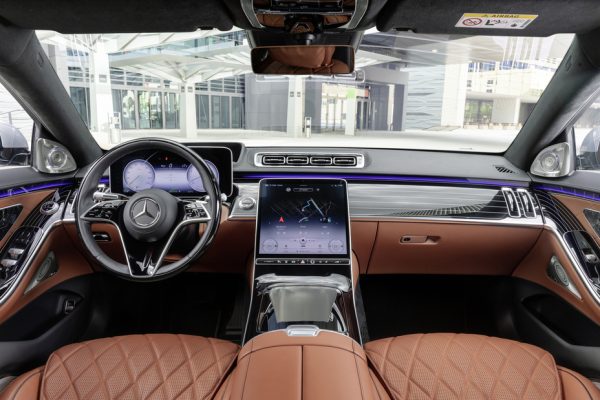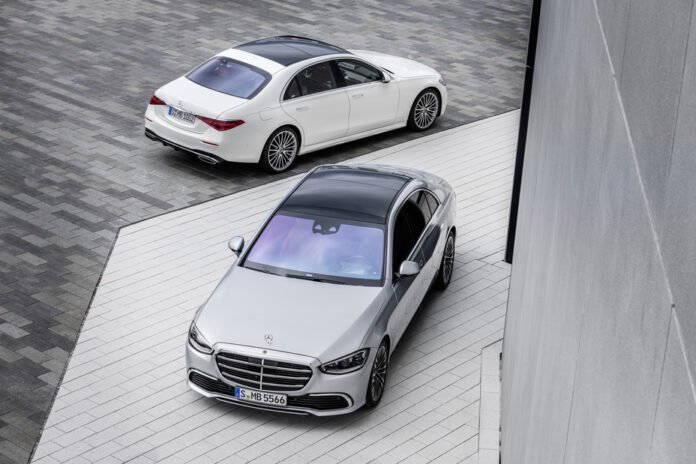The new Mercedes-Benz S-Class Glossary
The major innovations in detail
3D driver display: An impression of spatial depth is created when the eyes of a viewer perceive different perspective views of an object in the display. In this innovative auto-stereoscopic display, this is achieved by the sophisticated combination of a conventional LCD display with a special pixel structure and a controllable LCD aperture grille. What is known as a barrier mask is positioned a few millimetres in front of the LCD. It is so precisely adjusted to the head position of the viewer that the left and right eye see different pixels of the LCD. This creates the desired impression of depth. A stereo camera system is integrated into the display. This is used to precisely determine the eye position of the viewer. Thanks to methods developed by Mercedes-Benz to adapt distances and a very low-latency system configuration, the driver enjoys a wide range of free movement. The image in the driver display is continuously adjusted.
4D sound system: As well as 31 speakers of which two are Frontbass versions, the Burmester® high-end 4D surround sound system has eight exciters. Two exciters are integrated into the backrest of each seat. Direct reproduction of the sound resonance in the seats adds another level to the three-dimensional listening experience – 4D sound. The perceived intensity of the sound can be individually adjusted for each seat. The music becomes even more emotional thanks to this feelable component. In addition to music reproduction, the 4D sound is also used to create an even more emotional function of Energizing Comfort. Two amplifiers with a total output of 1750 watts power 37 separately processed output channels. Hybrid amplifier technology with digital signal processing, analogue filters and separate power supply ensure precise and highly dynamic sound reproduction.

Active ambience lighting: This uses fibre optics made of a transparent material. The light of the primary colours red, green and blue generated by the LEDs is reflected at the boundary between the optically more dense and the optically less dense material. In addition to a static light, the colours can alternate along the entire fibre optics in order to stage productions. The active ambient lighting is generated by a light band comprised of about 250 LEDs distributed side by side at a distance of 1.6 centimetres in the vehicle interior as an additional light plane. The optics are designed to create a continuous line of light. The networked LEDS are controlled in real time via a CAN data bus. Thanks to the actuation frequency of up to 25 Hz, the human eye is able to perceive dynamic lighting scenarios.
Augmented reality head-up display (AR-HUD): Two different head-up displays (HUDs) are available on request, one of them an innovative AR variant with a particularly large image. The aperture angle of the display is 10° horizontal and 5° vertical, and the image appears virtually at a distance of 10 metres. This display area corresponds to a monitor with a 77-inch diagonal. The AR-HUD provides a great deal of augmented reality content for driving assistance systems and navigation information. For the driver this blends into the surroundings ahead of the vehicle, and can therefore contribute to further reduced distraction. The image-forming unit (DMD, digital mirror device by Texas Instruments) consists of a high-resolution matrix of 1.3 mill. Individual mirrors and a highly efficient light source. The technology is also used by projectors in cinemas. In the S-Class it is used by Mercedes-Benz for the first time to generate images in the head-up display.

Drivertainment: Ear-level speakers integrated into the front seats make for further improved surround sound. With the new drivertainment function, information from the infotainment system, e.g. navigation instructions and telephony, can be specifically directed to the driver’s seat.
E-ACTIVE BODY CONTROL: adds semi-supporting hydropneumatics to the air suspension. The air springs bear the base load of the vehicle body and gradually regulate the level. The hydraulics generate dynamic forces that overlay the air suspension forces and actively support and dampen the vehicle body, e.g. during longitudinal and lateral acceleration or when driving on uneven roads. At each wheel, a damper is installed within the axle with two working chambers that have an adjustable damping valve and a hydraulic pressure reservoir. The damper is connected to an intelligent motor/pump unit in the 48 V network by hydraulic lines. Actuation of the motor/pump unit enables the hydraulic fluid to be displaced to create a difference in pressure within the damper, allowing an active force to be generated. The motor/pump units at all four wheels are coordinated by a central control unit which also actuates the valves and the compressor for the air springs, and therefore always controls the entire suspension system.
ENERGIZING seat kinetics: ENERGIZING seat kinetics uses the electric seat adjustment. If the driver selects this program, the inclination of the seat cushions and backrests is continuously adjusted minutely using the seat settings selected by the driver and the front passenger as the starting point. The changes are only minimal – a few degrees or millimetres. If multicontour seats are installed, the ENERGIZING seat kinetics also includes the lumbar support function. ENERGIZING seat kinetics improves spinal health, because the natural strain and relief of muscles, joints and discs can lead to muscle relaxation and an improved supply of nutrients to the joints and discs. ENERGIZING seat kinetics is based on a patented algorithm. Convenient selection of the programs is visually supported via the central display of MBUX (Mercedes-Benz User Experience).
Rear airbag: Cylindrical, tubular structures are inflated with compressed gas and deploy a wing-shaped structure. A large, tent-like airbag deploys between the two wings, and this is inflated by the surrounding air via specially patented valves in the skin. These valves are designed to hinder the escape of air when the rear passenger is immersed in the airbag. The comparatively small volume of the tubes allows rapid deployment of a relatively large airbag volume. This takes place with comparatively low force and a low risk of injury, as the tubular wings give way to obstacles. The airbag enhances the restraining effect of the belt system, and can support the head and neck to decrease the loads on them significantly. In combination with a beltbag and the inflatable seat belt, the S-Class sets new standards for rear seat occupant safety.
Rear-axle steering: An electric motor drives a spindle at the rear axle via a drive belt. This makes axial adjustments to the spindle. Depending on the speed and the steering angle, the rear wheels are turned in the same or the opposite direction as the front wheels (same-direction or counter-direction steering). In simplified terms, this produces more agility and a smaller turning circle by counter-steering and more stability with same-direction steering. In the S-Class, the full steering angle of ten degrees is especially used during parking manoeuvres. The environmental data of the vehicle sensors (radar, camera, ultrasonic) are used for large steering angles, to adapt the maximum angle to the relevant situation. The system switches from counter-direction to same-direction steering at more than 60 km/h. The different driving modes rely on different steering strategies. The respective rear-axle angles and trajectories are shown in the driving mode menu in the central display. The 10° rear axle steering has a special snowchain mode. When activated by the driver, the steering angle at the rear axle is reduced and the steering characteristics are adapted for the special conditions of surface snow.
Sound personalization: With this function the user can experiment and adjust the sound system to his/her personal listening preferences. The result is saved to a personal sound set and stored in the user profile.
MBUX Interior Assist: Using cameras in the overhead control panel and learning algorithms, MBUX Interior Assist recognizes and anticipates the wishes and intentions of the occupants. It does this by interpreting head direction, hand movements and body language, and responds with corresponding vehicle functions. For example, if the driver looks over his/her shoulder towards the rear window, MBUX Interior Assist automatically opens the sunblind. If the driver is looking for something on the front passenger seat in the dark, it automatically switches the light on. Merely looking at one of the outside mirrors is enough to allow adjustment, without having to select it first. Natural hand movements are also recognised, and the driver or passengers can open the sliding sunroof touch-free. Preferred functions can be accessed with the help of the favourites gesture (hand with the index and middle finger spread in a V-shape). The driver and passengers can link personal favourites with the system. As well as enhancing operating convenience, MBUX Interior Assist improves safety. It checks whether a child seat on the front passenger seat is correctly attached, for example.
OLED technology: The abbreviation stands for Organic Light Emitting Diode. In contrast to LCD technology, an OLED display consists of several organic layers applied to a plastic substrate. The OLED display in the S-Class has a single facing, and provides a comprehensive control and display experience in combination with the actuators and pressure sensors behind it. Evaluation of the pressure exerted and haptic confirmation of touch commands makes extended functionalities possible. OLED panels emit light when subjected to an electric current, and unlike an LCD they do not require external background lighting. Power is only consumed where pixels light up. Among other benefits, this ensures a better black level and even stronger contrasts. When showing typical video sequences, OLED technology has an up to 30 percent lower energy consumption than LCD technology.
PRE-SAFE® Impulse Side: In addition to the familiar functions, the body of the new S-Class can be slightly raised just before the collision when a side impact threatens. The side-mounted radar sensors are able to recognise and track a potential side crash at an early stage. The actuator is the E-ACTIVE BODY CONTROL suspension, which can raise the body upwards by up to 80 millimetres. This reduces the loads on the door structures, as the door sill can absorb more of the load thanks to its higher position. As a result, deformation of the passenger cell and the loads acting on the occupants can be reduced.
Voice assistant “Hey Mercedes”: Conventional voice control systems in cars call for certain fixed commands from their users. Because it understands natural language, “Hey Mercedes” listens to almost every word and understands practically any sentence relating to the infotainment sector and vehicle operation in 27 languages. Indirect speech is also recognised, for instance if the user says “I am cold” instead of the clear command “Temperature in footwell 24 degrees” in order to operate the climate control for the footwell. The voice control is also capable of learning. On the one hand it tunes into the user and their voice and also understands non-native speakers better; on the other hand the software models on the server learn new buzzwords or changing use of language with time. The system also no longer answers stereotypically, but varies in the dialogue output too. The fundamental way the language assistant operates: the voice input is freed from background noises, compressed and transmitted. Both the head unit in the vehicle and the server evaluate the data and send a reply. The system decides which reply is the most likely, then within a few seconds the reply/reaction follows. This means that the voice assistant also answers if there is no connectivity. “Hey Mercedes” is now available to every seat occupant.
(Source: https://www.mercedes-benz.ca/en/home)






